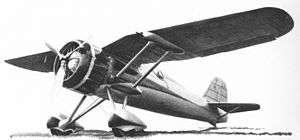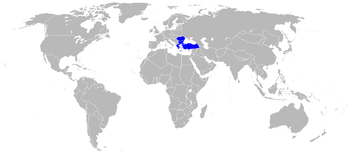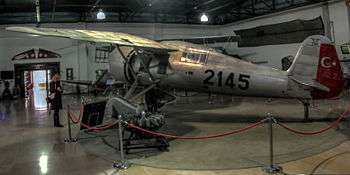PZL P.24
| PZL P.24 | |
|---|---|
 | |
| The second prototype of the PZL P.24 | |
| Role | fighter |
| Manufacturer | PZL IAR |
| Designer | Zygmunt Puławski |
| First flight | May 1933 |
| Introduction | 1936 |
| Retired | 1960 Turkish Air Force [1] |
| Primary user | Royal Romanian Air Force Bulgarian Air Force Hellenic Air Force |
| Developed from | PZL P.11 |
| Variants | IAR 80 |
The PZL P.24 was a Polish fighter aircraft, designed in mid-1930s in the PZL factory in Warsaw. It was exported to several countries, but not used in Poland.
Design and development
The PZL P.24 was developed as an export version of the PZL P.11, a gull-wing all-metal fighter designed by Zygmunt Puławski. The P.11 was powered with a license-built Bristol Mercury engine. The license did not permit export sales, so the French Gnome-Rhône company proposed using their engines in the P.11. The first P.24/I prototype, based on the P.11a and powered by a Gnome-Rhône 14Kds 760 hp (570 kW) engine, was flown in May 1933. The second P.24/II prototype, named the "Super P.24", set a world speed record for radial engine-powered fighters (414 km/h). The third P.24/III prototype was the "Super P.24bis" with a more powerful 14Kfs engine. The type was shown at the Paris air show in 1934 attracting great interest from the participants.
The aircraft was conventional in layout, with high wings. It was all-metal and metal-covered. The wings had a gull-wing shape, with a thin profile close to the fuselage, to provide a good view for the pilot. This configuration was developed by Zygmunt Puławski and called "the Polish wing". The canopy was closed (apart from prototypes). An internal 360 liter fuel tank in the fuselage could be dropped in case of fire emergency. It had conventional fixed landing gear, with a rear skid.
The armament was a combination of 20 mm Oerlikon FF cannon and 7.92 mm Colt-Browning machine guns in the wings.
- P.24A, P.24E and P.24F had two cannon and two machine guns.
- P.24B, P.24C and P.24G had four machine guns.
Operational history
Despite being a better fighter than the PZL P.11, none were acquired by the Polish Air Force, which preferred to wait for the PZL.50. When it became clear the PZL.50 would not be ready in time to counter the imminent German attack, the PAF briefly considered ordering PZL-24H, but in the end ordered the P.11G as an interim measure. Despite such rumours, no PZL.24s were used in the Polish Campaign (the P.11 were commonly misidentified as the P.24 by the Germans). The aircraft had greater success abroad, though.
- Turkey
- Turkish P.24s were used for training until the late 1940s. Some were refitted with Pratt & Whitney Twin Wasp engines.
- Romania
- The Romanian Air Force already used PZL P.11Fs built under license in the IAR factory, and decided to acquire the P.24 as well. Romania bought five P.24Es and a production license, and built 25 IAR P.24E aircraft at the IAR factory between 1937 and 1939.[2] Some components of the P.24E, mainly its tail section, were used in construction of the Romanian low-wing fighter IAR 80. The fighters were used to guard Bucharest and the Ploieşti oilfields from Soviet bombers at the start of Operation Barbarossa. Flying from Otopeni military airbase, the PZL P.24 fighters managed to shoot down 37 unescorted VVS bombers.[3] The P.24E was also used for ground attack missions until the end of 1941 and after 1942 it was relegated to training duties because of its obsolescence.
- Greece
- The Royal Hellenic Air Force (EVA) is the only air force during World War II to operate the PZL.24 as its main fighter type. Two subtypes, thirty P.24F and six P.24G, were ordered and delivered in 1937-38. They were split between three Mirae Dioxeos (Fighter Squadrons): the 21st at Trikala, 22nd at Thessaloniki and 23rd at Larissa. The only other operational Greek fighters, stationed further south, were eight Bloch MB.151s and two each Gladiator Mk I and Avia B-534 II, both of which were of limited value. When Italy attacked in October 1940, the Polish fighter was the Greeks' only modern type in adequate numbers. However, by 1940, the PZL.24 was no longer a front-runner despite a powerful powerplant and satisfactory armament. It had no speed advantage over the Fiat Cr.42 nor could it outfly the nimble Italian biplane, while it was much slower than the Macchi MC.200 and the Fiat G.50 it was pitted against. Its armament was the only real advantage against the Italian fighters whose reliance on the slow firing Breda-SAFAT 12.7mm machine guns proved detrimental. The PZL.24F armed with two 20mm Oerlikon FF cannon and two MGs gave the Greeks a temporary edge in combat until lack of ammunition and spares forced EVA to re-arm all P.24Fs with 4x Colt–Browning 7.7 mm MG40 machine guns. Overall, the PZLs performed gallantly during the early period of the conflict, holding their own against impossible numerical odds and despite the fact that their main target were enemy bombers which forced them to fight at a disadvantage against enemy fighters. Italian claims of easy superiority over the Albanian front were vastly over-rated and their kill claims even exceeded the total number of operational fighters on the Greek side. Total Greek fighter losses -in combat- came to 24 a/c with the Greek fighter pilots claiming 64 confirmed kills and 24 probables (about two third bombers). By April 1941, however, lack of spares and attrition had forced EVA to merge the five surviving PZL.24s into one understrength squadron supported by five Gloster Gladiators Mk I and II and the two surviving MB.151s. These fought hopelessly against the Luftwaffe onslaught in April 1941 scoring 4 kills (two Hs-126, one Ju-87B and one Do-17) and losing most of their surviving a/c on the ground. None of the Pulawski fighters survived.
Variants
During the development of Pulawski fighters, a new version of the P.11, the P.11c, was developed for the Polish Air Force. It had a new, reconfigured fuselage, and the radial engine was lowered to give a pilot a better view. These changes were applied also to the new P.24 prototype, flown in 1936.
The P.24A and P.24B models could carry 4 x 12.5 kg bombs, while the P.24C, F and G could carry 2 x 50 kg bombs.
- P.24
- This design used the whole tail fuselage section from the P.11c, was powered with a Gnome-Rhône 14Kfs engine (930 hp), and was armed with two 20 mm cannon and two machine guns.
- P.24A
- It entered production as the P.24A.
- P.24B
- The P.24B version was armed with four machine guns.
- P.24C
- The P.24C was armed with four machine guns and two 50 kg bombs.
- P.24D
- The P.24D was developed for sale to Hungary, but it was not completed, Hungary purchasing the Fiat CR.32 instead.
- IAR P.24E
- The P.24E version was license-built in Romania by Industria Aeronautică Română as the IAR P.24E.
- P.24F
- The P.24F was armed with two cannon and two machine guns and bombs and powered with the more powerful 970 hp (720 kW) Gnome-Rhône 14N-07 engine.
- P.24G
- The last production version was the P.24G, produced from 1937 and powered with the more powerful 970 hp (720 kW) Gnome-Rhône 14N-07 engine. The P.24G was armed with four machine guns and bombs.
- P.24H
- The P.24H was to be powered with a Gnome-Rhône 14N-21 engine (1,100 hp) and carry four cannon or two cannon and two machine guns, but it was not completed. The P.24H was considered for purchase by the Polish Air Force, but progress was slow due to the P.24's similarity to the PZL P.11, which was already in service, and also interest in the hypothetically superior PZL.50 Jastrząb then under development. World War II started before any of these plans could be realized.
- P.24J
- The P.24J version was to be armed with four cannon and was to be sold for export.
Operators



- Polish Air Force had one PZL P.11g Kobuz which was used during Invasion of Poland. This aircraft, piloted by H. Szczęsny shot down two German aircraft on 14 and 15 of September. Usually this victorious aircraft is identified as a P.24.[4][N 1]
- The Bulgarian Air Force ordered 14 PZL P.24Bs in 1937–1938.
- The Royal Hellenic Air Force bought 30 P.24Fs and six P.24Gs in 1936. Delivered 1937-38. All Fs eventually re-armed with 4x Colt–Browning 7.7mm MGs.
- The Royal Romanian Air Force ordered five PZL P.24E fighters in 1937 and built 25 IAR P.24E aircraft under license.[5]
- The Turkish Air Force ordered 14 P.24A and 26 P.24C, delivered by 1937. Another 20 P.24A/Cs were built under license in Turkey in Kayseri, followed by an additional 30 P.24G aircraft.
Survivors
The only surviving example of a PZL P.24 in the world is an example in Turkey. Photographs of the Turkish museum piece show a variety of serial numbering (2015, 2017, 2145, 2147) and are shot at different locations: (Ankara and Istanbul), suggesting that there may be more than one survivor.[N 2]
Specifications
Specifications (P.24A, P.24B, P.24C)
General characteristics
- Crew: 1
- Capacity: fighter
- Length: 7.50 m (22.96 ft)
- Wingspan: 10.71 m (32,80 ft)
- Height: 2.69 m (8.82 ft)
- Wing area: 17.90 m² (192.7 ft²)
- Empty weight: 1,327 kg (2,925 lb)
- Loaded weight: 1,870 kg (4,121 lb)
- Max. takeoff weight: 2,000 kg (4,400 lb)
- Powerplant: 1 × Gnome-Rhône 14Kfs 14-cylinder double row radial engine, 900 hp / 930 hp (max) (671 kW / 693 kW (max))
Performance
- Maximum speed: 410 km/h (254 mph)
- Range: 700 km (435 mi)
- Service ceiling: 9,000 m (29,527 ft)
- Rate of climb: 11 m/s (2,160 ft/min)
- Power/mass: 370.6 kW/tonne (451.5 hp/ton)
Armament
P.24A
- 2 MGs
- 2 20mm cannon
- 2 x 50 kg (110 lb) bombs
P.24B, P.24C
- 4 MGs
- 4 x 12,5 kg (27,5 lb) bombs
Specifications (P.24E)
General characteristics
- Crew: 1
- Capacity: fighter
- Length: 7.50 m (22.96 ft)
- Wingspan: 10.71 m (32,80 ft)
- Height: 2.69 m (8.82 ft)
- Wing area: 17.90 m² (192.7 ft²)
- Empty weight: 1,327 kg (2,925 lb)
- Loaded weight: 1,900 kg (4,188 lb)
- Max. takeoff weight: 2,000 kg (4,400 lb)
- Powerplant: 1 × Gnome-Rhône 14KIIc32 14-cylinder double row radial engine, 900 hp / 930 hp (max) (671 kW / 693 kW (max))
Performance
- Maximum speed: 408 km/h (253 mph)
- Range: 700 km (435 mi)
- Service ceiling: 10,000 m (32,808 ft)
- Rate of climb: 11 m/s (2,160 ft/min)
- Power/mass: 364.7 kW/tonne (445 hp/ton)
Armament
- 2 MGs
- 2 20mm cannon
- 2 x 50 kg (110 lb) bombs
Specifications (P.24F, P.24G)
General characteristics
- Crew: 1
- Capacity: fighter
- Length: 7.81 m (22.96 ft)
- Wingspan: 10.68 m (32,80 ft)
- Height: 2.69 m (8.82 ft)
- Wing area: 17.90 m² (192.7 ft²)
- Empty weight: 1,329 kg (2,930 lb)
- Loaded weight: 2,000 kg (4,409 lb)
- Max. takeoff weight: 2,000 kg (4,400 lb)
- Powerplant: 1 × Gnome-Rhône 14N-07 14-cylinder double row radial engine, 970 hp (700 kW)
Performance
- Maximum speed: 430 km/h (267 mph)
- Range: 700 km (435 mi)
- Service ceiling: 10,000 m (32,808 ft)
- Rate of climb: 11,1 m/s (2,165 ft/min)
- Power/mass: 350 kW/tonne (440.1 hp/ton)
Armament
P.24F
- 2 MGs
- 2 20mm cannon
- 2 x 50 kg (110 lb) bombs
P.24G
- 4 MGs
- 4 x 12,5 kg (27,5 lb) bombs
References
Notes
- ↑ This P.11 aircraft had flown to Romania on 17 September 1939 and later was modernised to P.24 standards, fitted with a Mercury VIII 9-cylinder radial.
- ↑ There is more than one example in Turkish possession: one aircraft is in the Istanbul Aviation Museum, another one is in THK museum, Ankara, and at least one full-scale fiberglass replica is exhibited in other museums in Turkey.
Citations
Bibliography
- Axworthy, Mark. Third Axis, Fourth Ally. London: Arms and Armour, 1995. ISBN 1-85409-267-7.
- Bernád, Dénes. Rumanian Air Force: The Prime Decade 1938-1947. Carrollton, TX: Squadron/Signal Publications Inc, 1999. ISBN 0-89747-402-3.
- Cynk, Jerzy B. Polish Aircraft 1893-1939. London: Putnam & Company Ltd., 1971. ISBN 0-370-00085-4.
- Cynk, Jerzy B. The P.Z.L. P-24 (Aircraft in Profile no. 170). Leatherhead, Surrey, UK: Profile Publications Ltd., 1967.
- Eberspacher, Warren and Jan P. Koniarek. PZL Fighters Part Three - P.24 Variants. Austin, CO: Creative & Customized Support, 2002.
- Glass, Andrzej. Polskie konstrukcje lotnicze 1893-1939 (in Polish). Warszawa, Poland: WKiŁ, 1976. No ISBN.
- Glass, Andrzej. PZL P.24 (Wydawnictwo Militaria 2) (in Polish). Warszawa, Poland: Wydawnictwo Militaria, 1994. ISBN 83-86209-13-5.
- Glass, Andrzej. PZL P.24 A-G (Monographie no.7) (Bilingual Polish/English). Lublin, Poland: Kagero, 2004. ISBN 83-89088-33-9.
- Green, William. War Planes of the Second World War, Volume Three: Fighters. London: Macdonald & Co.(Publishers) Ltd., 1961. ISBN 0-356-01447-9.
- Napier, Sid. "Le PZL P.24 en Grèce" (In French). AirMagazine, No. 34, October–November 2006.
- Skulski, Przemyslaw. PZL P.24 (Seria "Pod Lupą" 15) (in Polish with English captions). Wrocław, Poland: ACE Publication, 2002. ISBN 83-86153-24-5.
- Skulski, Przemyslaw. "PZL P.24, The Last Polish Gull-wing Fighter". Scale Aviation Modeller International, Vol. 10, Issue 9, September 2004.
External links
- A large collection of Greek P24 photos and profiles of most individual aircraft
- The Greek pilots fighting with PZLs - 1940
See also
| Wikimedia Commons has media related to PZL.24. |
- Related development
- Aircraft of comparable role, configuration and era
- Related lists